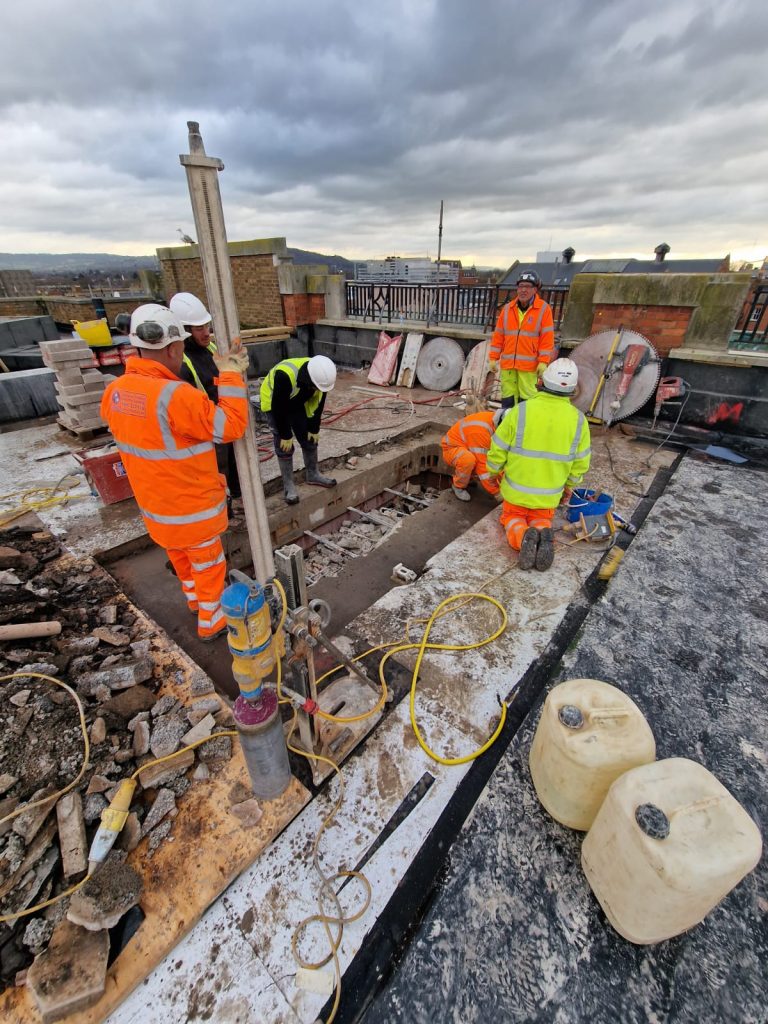Ensuring Safety, Reducing Risk, & Driving Excellence
At Doccer, we specialize in delivering tailored health and safety documentation to support Tier 1 and Tier 2 construction projects across the UK. Our bespoke solutions include comprehensive Method Statements, Risk Assessments, and Inspection Test Plans, meticulously designed to meet the unique demands of each client and project.
With a commitment to industry excellence, Doccer empowers construction firms to meet stringent regulatory standards, minimize risks, and ensure operational efficiency. Our expert team combines technical knowledge with an in-depth understanding of UK construction safety requirements, helping our clients maintain full compliance while fostering a safe working environment.
Whether working on large-scale infrastructure or smaller bespoke builds, Doccer stands as your trusted partner, ensuring that your safety documentation is not just compliant but also practical and aligned with your project’s goals.

Inspection Test Plans
What is an Inspection Test Plan and what does it include ?
- Scope of Work: The ITP begins by defining the scope of the project, detailing the specific components, materials, and systems that will be subject to inspection and testing.
- Inspection and Testing Requirements: The plan outlines the specific inspections and tests required for each phase of construction. This includes identifying applicable standards, codes, and specifications that must be adhered to, such as local building codes or industry standards.
- Inspection Schedule: The ITP includes a schedule detailing when inspections and tests will occur during the construction timeline. This ensures that inspections are conducted at critical stages and that any necessary corrective actions can be taken promptly.
- Responsibilities: The document specifies the roles and responsibilities of personnel involved in the inspection and testing process, including inspectors, contractors, and quality control personnel. This clarity helps to ensure accountability and effective communication.
- Acceptance Criteria: The ITP defines the acceptance criteria for each inspection and test, specifying the requirements that must be met for materials and workmanship to be deemed satisfactory. This could include tolerances, performance standards, and quality metrics.
- Documentation and Reporting: The plan outlines how inspection and testing results will be documented, including the format of reports, records to be maintained, and procedures for addressing non-conformance issues. This documentation is essential for tracking progress and compliance.
- Corrective Actions: The ITP details procedures for managing non-conformance, including how issues will be identified, documented, and rectified. This section ensures that any deviations from the plan are addressed efficiently to maintain project quality.
What is the purpose of an inspection test plan ?
- Quality Assurance: The primary purpose of an ITP is to ensure that all construction work meets specified quality standards. It serves as a systematic approach to identifying and addressing potential quality issues before they escalate.
- Compliance: An ITP helps ensure compliance with relevant building codes, regulations, and industry standards. It provides a framework for verifying that all construction activities adhere to required specifications.
- Risk Mitigation: By identifying inspection and testing requirements early in the project, an ITP helps mitigate risks associated with poor workmanship or material failure, ultimately reducing the likelihood of costly rework or delays.
- Enhancing Communication: The ITP serves as a communication tool among all project stakeholders, clarifying expectations, responsibilities, and procedures. This enhances collaboration between contractors, inspectors, and clients.
- Documentation and Traceability: The ITP provides a structured approach to documenting inspection and testing activities, which is essential for tracking project progress, providing evidence of compliance, and supporting future audits or inspections.
Method Statements
What is a Method Statement and what does it include ?
- Scope of Work: The method statement begins by clearly defining the scope of the work to be performed. This includes the specific tasks, activities, and processes involved in the construction project.
- Sequence of Operations: It outlines the step-by-step procedures for executing the work. This includes the order of operations, methodologies to be used, and the expected duration for each phase of the project.
- Resources and Materials: The document lists all resources required for the task, including tools, equipment, and materials. It may also specify the source of materials and any specific standards that need to be met.
- Roles and Responsibilities: A method statement defines the roles and responsibilities of all personnel involved in the construction process. This ensures accountability and clarity in communication among team members.
- Health and Safety Measures: One of the critical components of a method statement is its focus on health and safety. It identifies potential hazards associated with the work, outlines control measures to mitigate risks, and includes emergency procedures in case of incidents.
- Environmental Considerations: The method statement may also address environmental impacts and the measures taken to minimize adverse effects during construction, such as waste management and pollution control.
- Quality Assurance: It outlines quality control measures to ensure that the work meets specified standards and complies with relevant building codes and regulations.
What is the purpose of a Method Statement ?
- Safety Compliance: To ensure the health and safety of workers and the public by identifying risks and outlining control measures.
- Project Clarity: To provide a clear understanding of the project tasks, sequence, and expectations, minimizing confusion and errors.
- Efficiency: To streamline construction processes, making them more efficient by providing a structured approach to executing tasks.
- Regulatory Compliance: To demonstrate adherence to legal and industry regulations, which is often required for permits and inspections.
Communication Tool: To serve as a reference for all stakeholders, including contractors, subcontractors, and clients, ensuring everyone is aligned on the project’s execution.
Risk Assesments
What is a Risk Assessment and What does it include ?
- Hazard Identification: The first step involves identifying potential hazards associated with the construction site and activities. This may include physical hazards (e.g., machinery, falling objects), chemical hazards (e.g., exposure to toxic substances), biological hazards (e.g., mold, bacteria), and ergonomic hazards (e.g., repetitive movements, heavy lifting).
- Risk Evaluation: After identifying hazards, the next step is to evaluate the risks associated with each hazard. This involves analyzing the likelihood of an incident occurring and the potential severity of its consequences. This assessment helps prioritize which risks require immediate attention and mitigation.
- Control Measures: Once risks have been evaluated, the assessment outlines control measures to mitigate or eliminate identified hazards. This may include engineering controls (e.g., safety barriers, ventilation systems), administrative controls (e.g., training, work procedures), and personal protective equipment (PPE) (e.g., helmets, gloves).
- Implementation Plan: The risk assessment often includes a plan for implementing the control measures. This plan outlines who is responsible for each action, the timeline for implementation, and the resources needed.
- Monitoring and Review: A risk assessment is not a one-time task. It should be regularly reviewed and updated to reflect any changes in the project scope, site conditions, or emerging risks. Continuous monitoring ensures that control measures are effective and that new hazards are addressed promptly.
- Documentation: All findings, evaluations, and action plans from the risk assessment should be documented comprehensively. This documentation serves as a record for compliance, provides a basis for safety training, and helps in audits and inspection.
What is the purpose of a risk assessment ?
- Enhancing Safety: The primary purpose of a risk assessment is to identify and mitigate risks, thereby reducing the likelihood of accidents, injuries, and fatalities on construction sites.
- Regulatory Compliance: Many regions require formal risk assessments as part of health and safety regulations. Conducting a thorough assessment ensures compliance with these legal requirements.
- Promoting Worker Awareness: By identifying hazards and control measures, a risk assessment raises awareness among workers about the risks associated with their tasks and encourages safe practices.
- Improving Project Efficiency: Identifying risks early allows for proactive management, which can prevent delays and disruptions caused by accidents or safety incidents.
- Enhancing Stakeholder Confidence: A comprehensive risk assessment demonstrates a commitment to safety, instilling confidence in clients, stakeholders, and the public regarding the management of the construction project.
Toolbox Talks
What is a Toolbox Talk?
- A short, informal safety meeting held on construction sites.
- Focuses on specific safety topics relevant to the job or site.
- Typically conducted at the beginning of a shift or before starting a task.
- Encourages open communication about hazards and safety concerns.
- Often led by supervisors, foremen, or safety officers.
Benefits of Toolbox Talks for a Business
- Improves Safety Awareness: Reinforces safety procedures and promotes a proactive safety culture.
- Reduces Accidents and Incidents: Regular discussions about hazards help prevent workplace injuries.
- Enhances Compliance: Ensures workers are informed about safety regulations and company policies.
- Boosts Employee Engagement: Encourages workers to participate in safety conversations and report hazards.
- Saves Time and Costs: Reducing incidents lowers downtime, workers’ compensation claims, and legal expenses.
- Promotes Continuous Improvement: Provides feedback on safety issues, enabling proactive resolutions.
- Supports Documentation and Accountability: Records of talks can demonstrate a commitment to safety in audits or inspections
Sign up to Toolbox Talks – it’s free!
